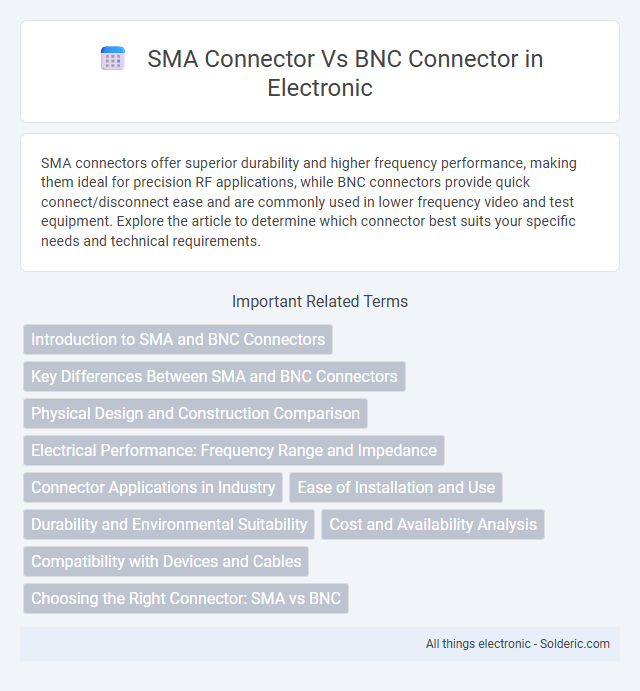SMA connectors offer superior durability and higher frequency performance, making them ideal for precision RF applications, while BNC connectors provide quick connect/disconnect ease and are commonly used in lower frequency video and test equipment. Explore the article to determine which connector best suits your specific needs and technical requirements.
Comparison Table
| Feature | SMA Connector | BNC Connector |
|---|---|---|
| Type | Threaded RF Connector | Bayonet RF Connector |
| Frequency Range | Up to 18 GHz (Some versions up to 26.5 GHz) | Up to 4 GHz (Standard BNC) |
| Impedance | 50 Ohms | 50 or 75 Ohms |
| Connection Mechanism | Threaded coupling | Bayonet locking |
| Size | Small, compact | Larger than SMA |
| Applications | High-frequency RF, microwave systems, antennas | Video, test equipment, radio frequency |
| Durability | High mechanical strength | Moderate mechanical strength |
| Cost | Higher | Lower |
Introduction to SMA and BNC Connectors
SMA connectors feature a threaded design optimized for high-frequency applications up to 18 GHz, providing reliable performance in RF and microwave systems. BNC connectors use a bayonet coupling mechanism, commonly supporting frequencies up to 4 GHz, and are widely used in video, audio, and low-frequency RF connections. Understanding the differences in construction and frequency handling helps you select the appropriate connector for your communication or testing equipment.
Key Differences Between SMA and BNC Connectors
SMA connectors offer superior performance with a higher frequency range up to 18 GHz and a more compact design compared to BNC connectors, which typically operate up to 4 GHz. You will find SMA connectors use a threaded coupling mechanism for enhanced mechanical stability, while BNC connectors rely on a bayonet-style coupling for quick connect and disconnect. The choice between SMA and BNC connectors depends on your specific application requirements for frequency, size, and connection security.
Physical Design and Construction Comparison
SMA connectors feature a compact, threaded design that provides secure, vibration-resistant connections ideal for high-frequency applications up to 18 GHz. BNC connectors use a bayonet coupling mechanism with a larger, bulkier housing suitable for quick connect and disconnect scenarios, typically supporting frequencies up to 4 GHz. Your choice depends on the need for precise, stable connections offered by SMA or the convenience and ruggedness of BNC fittings.
Electrical Performance: Frequency Range and Impedance
SMA connectors offer superior electrical performance with a frequency range up to 18 GHz and a precise 50-ohm impedance, making them ideal for high-frequency applications. BNC connectors typically operate up to 4 GHz and are available in 50-ohm and 75-ohm versions, suited for lower-frequency signal transmission. The consistent impedance of SMA connectors reduces signal reflection and ensures better signal integrity in RF and microwave systems compared to BNC connectors.
Connector Applications in Industry
SMA connectors are prevalent in high-frequency applications such as RF and microwave systems, telecommunications, and aerospace due to their reliable performance up to 18 GHz. BNC connectors dominate in broadcast, test equipment, and video signal transmission, supporting frequencies up to 4 GHz with quick connect/disconnect capabilities. Industrial sectors prioritize SMA for precision in military radar and satellite communications, while BNC is favored for lab instruments and analog video networking.
Ease of Installation and Use
SMA connectors offer a compact design with threaded coupling, providing secure and reliable connections ideal for applications requiring high-frequency performance. BNC connectors feature a bayonet-style coupling that enables quick and easy installation without the need for tools, making them user-friendly for frequent connect and disconnect scenarios. Your choice between these connectors depends on balancing the need for rapid installation against the requirement for a robust, vibration-resistant connection.
Durability and Environmental Suitability
SMA connectors offer superior durability due to their threaded coupling mechanism, providing a secure connection ideal for environments with vibration and mechanical stress. BNC connectors, while easier to connect and disconnect with their bayonet locking system, are less resistant to harsh conditions and may degrade faster in outdoor or high-moisture settings. Your choice should consider SMA connectors for rugged, long-term installations requiring environmental resilience, whereas BNC connectors are suitable for indoor or temporary applications.
Cost and Availability Analysis
SMA connectors typically have a higher cost due to their precision manufacturing and superior frequency performance, making them more common in professional RF and microwave applications. BNC connectors are generally more affordable and widely available, especially for lower-frequency signals in video and networking equipment. Your choice depends on budget constraints and intended use, as BNC offers cost-effective solutions while SMA provides enhanced reliability and precision.
Compatibility with Devices and Cables
SMA connectors offer superior compatibility with high-frequency devices and cables, supporting ranges up to 18 GHz, making them ideal for RF and microwave applications. BNC connectors are commonly compatible with lower-frequency devices and cables, typically up to 4 GHz, widely used in audio, video, and networking equipment. Your choice depends on the frequency requirements and the type of equipment you need to connect for optimal performance.
Choosing the Right Connector: SMA vs BNC
Selecting the right connector depends on application frequency and size constraints; SMA connectors excel in high-frequency applications up to 18 GHz with a compact, threaded design ensuring secure connections. BNC connectors are preferred for lower-frequency signals, typically below 4 GHz, offering quick bayonet coupling ideal for video and radio equipment. Understanding the operating frequency, durability, and connection reliability requirements guides the optimal choice between SMA's precision and BNC's versatility.
SMA connector vs BNC connector Infographic

 solderic.com
solderic.com